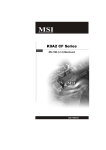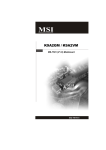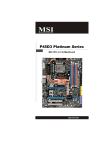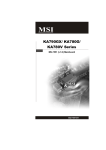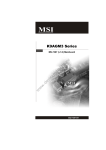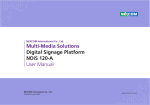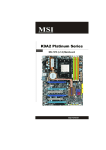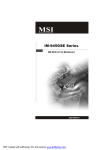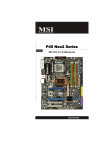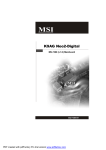Download MSI MS-7304 User`s manual
Transcript
MS-7304 (V1.X) Mainboard i Copyright Notice T he material in this doc ument is the intellec tual property of M ICRO-STAR INTERNATIONAL. We take every care in the preparation of this document, but no guarantee is given as to the correctness of its contents. Our products are under continual improvement and we reserve the right to make changes without notice. Trademarks All trademarks are the properties of their respective owners. Intel® and Pentium® are registered trademarks of Intel Corporation. AMD, Athlon™, Athlon™ XP, Thoroughbred™, and Duron™ are registered trademarks of AMD Corporation. NVIDIA, the NVIDIA logo, DualNet, and nForce are registered trademarks or trademarks of NVIDIA Corporation in the United States and/or other countries. PS/2 and OS ® /2 are registered trademarks of International Business Machines Corporation. W indows ® 95/98/2000/NT/XP are registered trademarks of Microsoft Corporation. Netware® is a registered trademark of Novell, Inc. Award® is a registered trademark of Phoenix Technologies Ltd. AMI® is a registered trademark of American Megatrends Inc. Revision History Revision Revision History Date V1.0 First release February 2008 Technical Support If a problem arises with your system and no solution can be obtained from the user’s manual, please contact your place of purchase or local distributor. Alternatively, please try the following help resources for further guidance. Vis i t the MSI webs ite at http ://glob al.msi. com.tw /index. php? func=faqIndex for FAQ, technical guide, BIOS updates, driver updates, and other information. Contact our technical staff at http://support.msi.com.tw/. ii Safety Instructions 1. Always read the safety instructions carefully. 2. Keep this User’s Manual for future reference. 3. Keep this equipment away from humidity. 4. Lay this equipment on a reliable flat surface before setting it up. 5. The openings on the enclosure are for air convection hence protects the equipment from overheating. DO NOT COVER THE OPENINGS. 6. Make sure the voltage of the power source and adjust properly 110/220V before connecting the equipment to the power inlet. 7. Place the power cord such a way that people can not step on it. Do not place anything over the power cord. 8. Always Unplug the Power Cord before inserting any add-on card or module. 9. All cautions and warnings on the equipment should be noted. 10. Never pour any liquid into the opening that could damage or cause electrical shock. 11. If any of the following situations arises, get the equipment checked by service personnel: The power cord or plug is damaged. Liquid has penetrated into the equipment. The equipment has been exposed to moisture. The equipment does not work well or you can not get it work according to User’s Manual. The equipment has dropped and damaged. The equipment has obvious sign of breakage. 12. DO NOT LEAVE THIS EQUIPMENT IN AN ENVIRONMENT UNCONDITIONED, STORAGE TEMPERATURE ABOVE 600 C (1400F), IT MAY DAMAGE THE EQUIPMENT. CAUTION: Danger of explosion if battery is incorrectly replaced. Replace only with the same or equivalent type recommended by the manufacturer. iii FCC-B Radio Frequency Interference Statement T h is eq uip men t h as been tested and found to c omply with the limits for a Class B digital device, pursuant to Part 15 of the FCC Rules. These limits are designed to provide reasonable protection against harmful interference in a residential installation. This equipment generates, uses and can radiate radio frequency energy and, if not installed and used in accordance with the instructions, may cause harmful interference to radio communications. However, there is no guarantee that interference will not occur in a particular installation. If this equipment does cause harmful interference to radio or television reception, which can be determined by turning the equipment off and on, the user is encouraged to try to correct the interference by one or more of the measures listed below. Reorient or relocate the receiving antenna. Increase the separation between the equipment and receiver. Connect the equipment into an outlet on a circuit different from that to which the receiver is connected. Consult the dealer or an experienced radio/television technician for help. Notice 1 The changes or modifications not expressly approved by the party responsible for compliance could void the user’s authority to operate the equipment. Notice 2 Shielded interface cables and A.C. power cord, if any, must be used in order to comply with the emission limits. VOIR LA NOTICE D’INSTALLATION AVANT DE RACCORDER AU RESEAU. Micro-Star International MS-7304 This device complies with Part 15 of the FCC Rules. Operation is subject to the following two conditions: (1) this device may not cause harmful interference, and (2) this device must accept any interference received, including interference that may cause undesired operation. iv WEEE (Waste Electrical and Electronic Equipment) Statement v vi vii CONTENTS Copyright Notice .............................................................................................................. ii Trademarks ....................................................................................................................... ii Revision History .............................................................................................................. ii Technical Support ........................................................................................................... ii Safety Instructions ......................................................................................................... iii FCC-B Radio Frequency Interference Statement ........................................................ iv W EEE (Waste Electrical and Electronic Equipment) Statement .................................... v Chapter 1 Getting Started ..................................................................................... 1-1 Mainboard Specifications ................................................................................... 1-2 Mainboard Layout ................................................................................................ 1-4 Chapter 2 Hardware Setup .................................................................................... 2-1 Quick Components Guide .................................................................................... 2-2 CPU (Central Processing Unit) ............................................................................ 2-3 Memory ................................................................................................................. 2-6 Power Supply ...................................................................................................... 2-8 Back Panel ............................................................................................................ 2-9 Connector ........................................................................................................... 2-11 Slot ...................................................................................................................... 2-16 Jumper ................................................................................................................ 2-17 Chapter 3 BIOS Setup ............................................................................................. 3-1 Entering Setup ..................................................................................................... 3-2 The Main Menu ..................................................................................................... 3-4 Standard CMOS Features ................................................................................... 3-6 Advanced BIOS Features ................................................................................... 3-8 Integrated Peripherals ........................................................................................ 3-11 Power Management Setup ............................................................................... 3-13 PNP/PCI Configurations ..................................................................................... 3-15 H/W Monitor ........................................................................................................ 3-17 Frequency/Voltage Control ............................................................................... 3-18 Load Fail-Safe / Optimized Defaults ................................................................ 3-21 Set Supervisor Password ................................................................................ 3-22 viii Getting Started Chapter 1 Getting Started Thank you for choosing the MS-7304 v1.X Micro-ATX mainboard. The MS-7304 is based on AMD® RS780 & SB700 chipsets for optimal system efficiency. Designed to fit the advanced AMD® Athlon64 / Athlon64 X2 / AM2+ processors in Socket AM2/ AM2+, the MS-7304 delivers a high performance and professional desktop platform solution. 1-1 M S-7304 M ainboard Mainboard Specifications Proce ssor - Supports AMD Athlon64 / Athlon64 X2 /AM2+ processors - Supports 4-pin CPU fan pinheader with Fan Speed Control - Supports up to 5000+ and above FSB - Hyper Transport supports up to 3.0GHz Chipset - North Bridge: AMD RS780 - South Bridge: AMD SB700 M e mo r y - DDR2 533/667/800/1066 SDRAM (240 pins / 1.8V) - 4 DDR2 DIMM slots (8GB Max) LAN - Gigabit Fast Ethernet by Realtek RTL8111C IEEE 1394 - Chip integrated by JMicron 381 - Transfer rate is up to 400MB/s Audio - Chip integrated by Realtek ALC888S - Flexible 8-channel audio with jack sensing - Com pliant with Azalia 1.0 Spec SATA - SATA II ports by SB700 - Supports 4 SATA II devices - Supports storage and data transfers at up to 300MB/s 1-2 Getting Started Connectors Back Panel - 1 SPDIF-out port - 1 DVI port - 1 IEEE 1394 port - 6 USB 2.0 ports - 1 Gigabit LAN jack - 6 flexible audio jacks Onboard Connectors - 2 USB 2.0 connectors (4 ports) - 1 IEEE 1394 connector - 1 SPDIF-out connector - 1 front panel connector - 1 front panel audio connector Slots - 1 PCI Express x16 slot - 1 PCI Express x1 slot - 2 32-bit/33MHz PCI slots Form Factor - M-ATX (24.4cm X 24.4 cm) M ounting - 8 mounting holes 1-3 M S-7304 M ainboard Mainboard Layout CPU_FAN1 JSPDO2 DVI Port AT X 1 USB Ports Top: 1394 Port Bottom: USB Ports Top: LAN Jack Bottom: USB Ports T: Line-In M: Line-Out B: Mic T: R S-Out M: CS-Out B: SS-Out AUX_FAN1 JPW1 D IM M 4 D IM M 3 D IM M 1 D IM M 2 AMD RS780 PCI E1_X1 BATT + PCI E16_X1 PCI 1 F_U SB2 S ATA 4 Audio C hip S AT A 1 PCI 2 S ATA 2 AMD SB700 S ATA 3 CLR_CMOS1 LA N Chip F_U SB1 JAUD 1 JSPDO1 J1394 JSPI1 MS-7304 (v1.X) Micro-ATX Mainboard 1-4 JFP1 Hardware Setup Chapter 2 Hardware Setup This chapter provides you with the information about hardware setup procedures. While doing the installation, be careful in holding the components and follow the installation procedures. For some components, if you install in the wrong orientation, the components will not work properly. Use a grounded wrist strap before handling computer c om ponen ts . S tatic elec tric ity m ay damage the components. 2-1 M S-7304 M ainboard Quick Components Guide Back Panel I/O, p.2-9 CPU _FAN 1, AUX_FAN1, p.2-12 JPW1, p.2-8 DIMM Slots, p.2-6 CPU, p.2-3 ATX1, p.2-8 BATT + CLR_CMOS1, p.2-16 PCI Express Slots, p.2-17 SATA1~4, p.2-11 PCI Slots, p.2-17 JAUD1, p.2-13 JSPDO1, p.2-12 2-2 F_USB1~2, p.2-14 J1394, p.2-14 JFP1, p.2-15 JSPI1, p.2-11 Hardware Setup CPU (Central Processing Unit) The mainboard supports AMD ® Athlon64 / Athlon64 X2 / AM2+ processors in Socket AM2/ AM2+. The Socket AM2/ AM2+ offers easy CPU installation. W hen you are installing the CPU, make sure the CPU has a heat sink and a cooling fan attached on the top to prevent overheating. If you do not have the heat sink and cooling fan, contact your dealer to purchase and install them before turning on the computer. For the latest information about CPU, please visit http://global.msi.com.tw/index. php?func=cpuform. Important Overheating Overheating will seriously damage the CPU and system. Always make sure the cooling fan can work properly to protect the CPU from overheating. Make sure that you apply an even layer of thermal paste (or thermal tape) between the CPU and the heatsink to enhance heat dissipation. Replacing the CPU While replacing the CPU, always turn off the power supply or unplug the power supply’s power cord from the grounded outlet first to ensure the safety of CPU. 2-3 M S-7304 M ainboard CPU Installation Procedures for Socket AM2/ AM2+ 1. Please turn off the power and unplug the power cord before installing the CPU. 2. Pull the lever s ideways away from the socket. Make sure that you raise the lever up to a 90degree angle. 3. Look for the gold arrow on the CPU. The gold arrow should point as shown in the picture. The CPU c an on l y f i t i n t h e c or r ec t orientation. Lower the CPU down onto the socket. 4. If the CPU is correctly installed, the pins should be completely embedded into the socket and can not be seen. Please note that any violation of the correct in s tal lati on p roc edur es m ay c aus e permanent damage to your mainboard. Open the lever Sliding the plate 90 degree Gold arrow Correct CPU placement Gold arrow O Incorrect CPU placement Gold arrow 5. Press the CPU down firmly into the socket and close the lever. As the CPU is likely to move while the lever is being closed, always close the lever with your fingers pressing tightly on top of the CPU to make sure the CPU is properly and completely embedded into the socket. 2-4 Press down the CPU Close the lever Hardware Setup Installing CPU Cooler Set W hen you are installing the CPU, make sure the CPU has a heat sink and a cooling fan attached on the top to prevent overheating. If you do not have the heat sink and cooling fan, contact your dealer to purchase and install them before turning on the computer. Important 1. Read the CPU status in BIOS (Chapter 3). 2. Mainboard photos shown in this section are for demonstration of the CPU/ cooler installation only. The appearance of your mainboard may vary depending on the model you purchase. 1. Position the cooling set onto the retention mechanism. Hook one end of the clip to hook first. 2. Then press down the other end of the clip to fasten the cooling set on the top of the retention mechanism. Locate the Fix Lever and lift up it . Fixed Lever 3. Fasten down the lever. 4. Attach the CPU Fan cable to the CPU fan connector on the mainboard. 2-5 M S-7304 M ainboard Memory These DIMM slots are intended for memory modules. For more information on compatible components, please visit http://global.msi.com. tw/index.php?func=testreport DDR2 240-pin, 1.8V 56x2=112 pin 64x2=128 pin Dual-Channel Memory Population Rules In Dual-Channel mode, the memory modules can transmit and receive data with two data bus lines simultaneously. Enabling Dual-Channel mode can enhance the system performance. Please refer to the following illustrations for population rules under Dual-Channel mode. 1 DIMM1 DIMM2 DIMM3 DIMM4 2 DIMM1 DIMM2 DIMM3 DIMM4 3 DIMM1 DIMM2 DIMM3 DIMM4 Installed Empty 2-6 Hardware Setup Installing Memory Modules 1. The memory module has only one notch on the center and will only fit in the right orientation. 2. Insert the memory module vertically into the DIMM slot. Then push it in until the golden finger on the memory module is deeply inserted in the DIMM slot. The plastic clip at each side of the DIMM slot will automatically close when the memory module is properly seated. Important You can barely see the golden finger if the memory module is properly inserted in the DIMM slot. 3. Manually check if the memory module has been locked in place by the DIMM slot clips at the sides. Volt Notch Important - In Dual-Channel mode, make sure that you install memory modules of the same type and density in different channel DIMM slots. - To enable successful system boot-up, always insert the memory modules into the DIM M1 first. - Due to the chipset resource deployment, the system density will only be detected up to 7+GB (not full 8GB) when each DIMM is installed with a 2GB memory module. 2-7 M S-7304 M ainboard Power Supply ATX 24-Pin Power Connector: ATX1 This connector allows you to connect an ATX 24-pin power supply. To connect the ATX 24-pin power supply, make sure the plug of the power supply is inserted in the proper orientation and the pins are aligned. Then push down the power supply firmly into the connector. You may use the 20-pin ATX power supply as you like. If you’d like to use the 20-pin ATX power supply, please plug your power supply along with pin 1 & pin 13 (refer to the image at the right hand). There is also a foolproof design on pin 11, 12, 23 & 24 to avoid wrong installation. pin 13 pin 12 Pin Definition 1 13 ATX1 12 24 PIN SIGNAL PIN SIGNAL 1 2 +3.3V +3.3V 13 14 +3.3V -12V 3 4 GND +5V 15 16 GND PS-ON# 5 6 GND +5V 17 18 GND GND 7 8 GND PWR OK 19 20 GND Res 9 10 5VSB +12V 21 22 +5V +5V 11 +12V 12 +3.3V 23 24 +5V GND ATX 12V Power Connector: JPW1 This power connector is used to provide power to the CPU. Pin Definition JPW1 3 4 1 2 PIN SIGNAL 1 2 GND GND 3 4 12V 12V Important 1. Make sure that all the connectors are connected to proper power supplies to ensure stable operation of the mainboard. 2. Power supply of 350 watts (and above) is highly recommended for system stability. 2-8 Hardware Setup Back Panel LAN IEEE 1394 Line-In RS-Out Line-Out CS-Out S/PDIF-Out DVI USB USB USB Mic SS-Out Coaxial S/PDIF-Out This SPDIF (Sony & Philips Digital Interconnect Format) connector is provided for digital audio transmission to external speakers through a coaxial cable. DVI Port The DVI (Digital Visual Interface) connector allows you to connect an LCD monitor. It provides a high-speed digital interconnection between the computer and its display device. To connect an LCD monitor, simply plug your monitor cable into the DVI connector, and make sure that the other end of the cable is properly connected to your monitor (refer to your monitor manual for more information.) USB Port The USB (Universal Serial Bus) port is for attaching USB devices such as keyboard, mouse, or other USB-compatible devices. IEEE 1394 Port The 1394 port on the back panel provides connection to 1394 devices. LAN The standard RJ-45 LAN jack is for connection to Local Area Network (LAN). You can connect a network cable to it. LED Color LED State Left Green On (steady state) Off Activity Indicator Link Indicator Condition LAN link is not established. LAN link is established. On (brighter & pulsing) The computer is communicating with another computer on the LAN. Green Right Orange Off 10 Mbit/sec data rate is selected. On 100 Mbit/sec data rate is selected. On 1000 Mbit/sec data rate is selected. 2-9 M S-7304 M ainboard Audio Ports These audio connectors are used for audio devices. You can differentiate the color of the audio jacks for different audio sound effects. Line-In (Blue) - Line In, is used for external CD player, tape player or other audio devices. Line-Out (Green) - Line Out, is a connector for speakers or headphones. Mic (Pink) - Mic, is a connector for microphones. RS-Out (Black) - Rear-Surround Out in 4/ 5.1/ 7.1 channel mode. CS-Out (Orange) - Center/ Subwoofer Out in 5.1/ 7.1 channel mode. SS-Out (Gray) - Side-Surround Out 7.1 channel mode. 2-10 Hardware Setup Connector SPI Flash ROM Connector: JSPI1 This connector is used to flash SPI flash ROM. Pin Definition JSPI1 10 2 9 1 Pin Description Pin Description 1 VCC3_SB 2 VCC3_SB 3 SPI_MISO_F 4 SPI_MOSI_F 5 SPI_CS0_F# 6 SPI_CLK_F 7 GND 8 GND 9 SPI_HOLD# 10 NC Serial ATA Connector: SATA1, SATA2, SATA3, SATA4 This connector is a high-speed Serial ATA interface port. Each connector can connect to one Serial ATA device. SATA2 SATA4 SATA3 SATA1 Important Please do not fold the Serial ATA cable into 90-degree angle. Otherwise, data loss may occur during transmission. 2-11 M S-7304 M ainboard S/PDIF-Out Connector: JSPDO1 This connector is used to connect S/PDIF (Sony & Philips Digital Interconnect Format) interface for digital audio transmission. SPDIF GND VCC JSPDO1 Fan Power Connector: CPU_FAN1, AUX_FAN1 The fan power connectors support system cooling fan with +12V. W hen connecting the wire to the connectors, always note that the red wire is the positive and should be connected to the +12V; the black wire is Ground and should be connected to GND. If the mainboard has a System Hardware Monitor chipset onboard, you must use a specially designed fan with speed sensor to take advantage of the CPU fan control. CONTROL SENSOR +1 2V GND CPU_FAN1 GND +1 2V SENSOR CONTROL AUX_FAN1 Important 1. Please refer to the recommended CPU fans at processor’s official website or consult the vendors for proper CPU cooling fan. 2. CPUFAN1 supports fan control. You can activate the Smart Fan function in the BIOS Setup Utility to automatically control the CPU fan speed according to the actual CPU temperature. 3. Fan/heatsink with 3 or 4 pins are both available for CPUFAN1. 2-12 Hardware Setup Front Panel Audio Connector: JAUD1 This connector allows you to connect the front panel audio and is compliant with Intel® Front Panel I/O Connectivity Design Guide. JAUD1 2 1 10 9 HD Audio Pin Definition PIN SIGNAL DESCRIPTION 1 2 MIC_L GND Microphone - Left channel Ground 3 4 MIC_R PRESENCE# Microphone - Right channel Active low signal-signals BIOS that a High Definition Audio dongle is connected to the analog header. PRESENCE# = 0 when a High Definition Audio dongle is connected 5 6 LINE out_R MIC_JD Analog Port - Right channel Jack detection return from front panel microphone JACK1 7 Front_JD Jack detection sense line from the High Definition Audio CODEC jack detection resistor network 8 9 NC LINE out_L No control Analog Port - Left channel 10 LINEout_JD Jack detection return from front panel JACK2 2-13 M S-7304 M ainboard IEEE1394 Connector: J1394 This connector allows you to connect the IEEE1394 device via an optional IEEE1394 bracket. Pin Definition J1394 2 1 10 9 PIN SIGNAL PIN SIGNAL 1 TPA+ 2 TPA- 3 Ground 4 Ground 5 TPB+ 6 TPB- 7 Cable power 8 Cable power 9 Key (no pin) 10 Ground Front USB Connector: F_USB1, F_USB2 This connector, compliant with Intel® I/O Connectivity Design Guide, is ideal for connecting high-speed USB interface peripherals such as USB HDD, digital cameras, M P3 players, printers, modems and the like. Pin Definition 2 1 10 9 F_USB1, F_USB2 PIN SIGNAL PIN SIGNAL 1 VCC 2 VCC 3 USB0- 4 USB1- 5 USB0+ 6 USB1+ 7 GND 8 GND 9 Key (no pin) 10 USBOC Important Note that the pins of VCC and GND must be connected correctly to avoid possible damage. 2-14 Hardware Setup Front Panel Connector: JFP1 This connector is provided for electrical connection to the front panel switches/LEDs and is compliant with Intel® Front Panel I/O Connectivity Design Guide. Power Power LED Switch + - JFP1 2 1 10 9 + - - + HDD Reset LED Switch JFP1 Pin Definition PIN SIGNAL DESCRIPTION 1 2 HD_LED + FP PWR/SLP Hard disk LED pull-up MSG LED pull-up 3 4 HD_LED FP PWR/SLP Hard disk active LED MSG LED pull-up 5 6 RST_SW PWR_SW + Reset Switch low reference pull-down to GND Power Switch high reference pull-up 7 8 RST_SW + PWR_SW - Reset Switch high reference pull-up Power Switch low reference pull-down to GND 9 RSVD_DNU Reserved. Do not use. 2-15 M S-7304 M ainboard Jumper Clear CMOS Jumper: CLR_CMOS1 There is a CMOS RAM onboard that has a power supply from an external battery to keep the data of system configuration. W ith the CMOS RAM, the system can automatically boot OS every time it is turned on. If you want to clear the system configuration, set the jumper to clear data. CLR_CMOS1 1 3 1 Keep Data 3 1 Clear Data Important You can clear CMOS by shorting 2-3 pin while the system is off. Then return to 1-2 pin position. Avoid clearing the CMOS while the system is on; it will damage the mainboard. 2-16 Hardware Setup Slot PCI (Peripheral Component Interconnect) Express Slot The PCI Express slot supports the PCI Express interface expansion card. The PCI Express x 16 slot supports up to 4.0 GB/s transfer rate. The PCI Express x 1 slot supports up to 250 MB/s transfer rate. PCI Express x16 Slot PCI Express x1 Slot PCI (Peripheral Component Interconnect) Slot The PCI slot supports LAN card, SCSI card, USB card, and other add-on cards that comply with PCI specifications. 32-bit PCI Slot Important When adding or removing expansion cards, make sure that you unplug the power supply first. Meanwhile, read the documentation for the expansion card to configure any necessary hardware or software settings for the expansion card, such as jumpers, switches or BIOS configuration. 2-17 M S-7304 M ainboard PCI Interrupt Request Routing The IRQ, acronym of interrupt request line and pronounced I-R-Q, are hardware lines over which devices can send interrupt signals to the microprocessor. The PCI IRQ pins are typically connected to the PCI bus pins as follows: Order 1 Order 2 Order 3 Order 4 PCI Slot 1 INT A# INT B# INT C# INT D# PCI Slot 2 INT B# INT C# INT D# INT A# 2-18 BIOS Setup Chapter 3 BIOS Setup This chapter provides information on the BIOS Setup program and allows you to configure the system for optimum use. You may need to run the Setup program when: ² An error message appears on the screen during the system booting up, and requests you to run SETUP. ² You want to change the default settings for customized features. 3-1 M S-7304 M ainboard Entering Setup Power on the computer and the system will start POST (Power On Self Test) process. W hen the message below appears on the screen, press <DEL> key to enter Setup. Press DEL to enter SETUP If the message disappears before you respond and you still wish to enter Setup, restart the system by turning it OFF and On or pressing the RESET button. You may also restart the system by simultaneously pressing <Ctrl>, <Alt>, and <Delete> keys. Important 1. The items under each BIOS category described in this chapter are under continuous update for better system performance. Therefore, the description may be slightly different from the latest BIOS and should be held for reference only. 2. Upon boot-up, the 1st line appearing after the memory count is the BIOS version. It is usually in the format: A7304AMS V1.0 011308 where: 1st digit refers to BIOS maker as A = AMI, W = AWARD, and P = PHOENIX. 2nd - 5th digit refers to the model number. 6th digit refers to the chipset as I = Intel, N = nVidia, A = AMD and V = VIA. 7th - 8th digit refers to the customer as MS = all standard customers. V1.0 refers to the BIOS version. 011308 refers to the date this BIOS was released. 3-2 BIOS Setup Control Keys < ↑> Move to the previous item < ↓> Move to the next item < ←> Move to the item in the left hand < →> Move to the item in the right hand <Enter> Select the item <Esc> Jumps to the Exit menu or returns to the main menu from a submenu <+/PU> Increase the numeric value or make changes <-/PD> Decrease the numeric value or make changes <F6> Load Optimized Defaults <F7> Load Fail-Safe Defaults <F10> Save configuration changes and exit setup Getting Help After entering the Setup menu, the first menu you will see is the Main Menu. M ain M enu The main menu lists the setup functions you can make changes to. You can use the arrow keys ( ↑↓ ) to select the item. The on-line description of the highlighted setup function is displayed at the bottom of the screen. Sub-M enu If you find a right pointer symbol (as shown in the right view) appears to the left of certain fields that means a sub-menu can be launched from this field. A sub-menu contains additional options for a field parameter. You can use arrow keys ( ↑↓ ) to highlight the field and press <Enter> to call up the sub-menu. Then you can use the control keys to enter values and move from field to field within a sub-menu. If you want to return to the main menu, just press the <Esc >. General Help <F1> The BIOS setup program provides a General Help screen. You can call up this screen from any menu by simply pressing <F1>. The Help screen lists the appropriate keys to use and the possible selections for the highlighted item. Press <Esc> to exit the Help screen. 3-3 M S-7304 M ainboard The Main Menu Standard CM OS Features Use this menu for basic system configurations, such as time, date etc. Advanced BIOS Features Use this menu to set up the items of AMI® special enhanced features. Integrated Peripherals Use this menu to specify your settings for integrated peripherals. Power M anagement Setup Use this menu to specify your settings for power management. PNP/PCI Configurations This entry appears if your system supports PnP/PCI. H/W M onitor This entry shows your PC health status. Frequency/Voltage Control Use this menu to specify your settings for frequency/voltage control and overclocking. 3-4 BIOS Setup Load Fail-Safe Defaults Use this menu to load the default values set by the BIOS vendor for stable system performance. Load Optimized Defaults Use this menu to load the default values set by the mainboard manufacturer specifically for optimal performance of the mainboard. Set Supervisor Password Use this menu to set the password for BIOS. Save & Exit Setup Save changes to CMOS and exit setup. Exit Without Saving Abandon all changes and exit setup. 3-5 M S-7304 M ainboard Standard CMOS Features Date (MM:DD:YY) This allows you to set the system to the date that you want (usually the current date). The format is <day><month> <date> <year>. day Day of the week, from Sun to Sat, determined by BIOS. Read only. mon th The month from Jan. through Dec. date The date from 1 to 31 can be keyed by numeric function keys. year The year can be adjusted by users. Time (HH:MM :SS) This allows you to set the system time that you want (usually the current time). The time format is <hour> <minute> <second>. 3-6 BIOS Setup SATA1, SATA2, SATA3, SATA4 Device, Vendor, Size It shows the information of the HDD that you connect to the SATA connector. LBA/Large M ode This allows you to enable or disable the LBA Mode. Setting to [Auto] enables LBA mode if the device supports it and the devices is not already formatted with LBA mode disabled. DM A M ode Select DMA Mode. Hard Disk S.M.A.R.T. This allows you to activate the S.M.A.R.T. (Self-Monitoring Analysis & Reporting Technology) capability for the hard disks. S.M.A.R.T is a utility that monitors your disk status to predict hard disk failure. This gives you an opportunity to move data from a hard disk that is going to fail to a safe place before the hard disk becomes offline. Halt On The setting determines whether the system will stop if an error is detected at boot. W hen the system stops for the errors preset, it will halt on for 15 seconds and then automatically resume its operation. System Information These items show the CPU information, BIOS version and memory status of your system (read only). 3-7 M S-7304 M ainboard Advanced BIOS Features Boot Sector Protection This function protects the BIOS from accidental corruption by unauthorized users or computer viruses. W hen enabled, the BIOS’ data cannot be changed when attempting to update the BIOS with a Flash utility. To successfully update the BIOS, you’ll need to disable this Flash BIOS Protection function. You should enable this function at all times. The only time when you need to disable it is when you want to update the BIOS. After updating the BIOS, you should immediately re-enable it to protect it against viruses. Full Screen LOGO Display This item enables you to show the company logo on the bootup screen. Settings are: [Enabled] Shows a still image (logo) on the full screen at boot. [Disabled] Shows the POST messages at boot. Quick Power On Self Test Setting the item to [Enabled] allows the system to boot within 5 seconds since it will skip some check items. Boot Up Num-Lock LED This setting is to set the Num Lock status when the system is powered on. Setting to [On] will turn on the Num Lock key when the system is powered on. Setting to [Off] will allow users to use the arrow keys on the numeric keypad. 3-8 BIOS Setup APIC Function This field is used to enable or disable the APIC (Advanced Programmable Interrupt Controller). Due to compliance with PC2001 design guide, the system is able to run in APIC mode. Enabling APIC mode will expand available IRQ resources for the system. MPS Table Version This field allows you to select which MPS (Multi-Processor Specification) version to be used for the operating system. You need to select the MPS version supported by your operating system. To find out which version to use, consult the vendor of your operating system. Optical Drive AAM This setting controls the Automatic Acoustic Management (AAM) function of the installed optical drive. CPU Feature Secure Virtual M achine M ode SVM (Secure Virtual Machine) technology provides a set of hardware extensions designed to enable economical and efficient implementation of virtual machine systems. Generally speaking, hardware support falls into two complementary c ategories : v irtualiz ation s upport and s ec urity s upport. Not all porcessors support SVM. Chipset Feature HPET in SB The High Precision Event Timer (HPET) was developed jointly by Intel and Microsoft to meet the timing requirements of multimedia and other time-sensitive applications. In addition to extending the capabilities and precision of a system, the HPET also improves system performance. UMA Frame Buffer Size Frame Buffer is the video memory that stores data for video display (frame). This field is used to determine the memory size for Frame Buffer. Larger frame buffer size increases video performance. Surround View SURROUNDVIEW™ provides the power and convenience of multi-adapter, multi- 3-9 M S-7304 M ainboard monitor support for computers that use an AGP- or PCI Express ®-based graphics card in conjunction with ATI integrated graphics processors (IGPs). Boot Sequence 1st Boot Device, 2nd Boot Device, 3rd Boot Device, CD/DVD Drives, Hard Disk Drives The items allow you to set the priority of the boot devices where BIOS attempts to load the disk operating system. 3-10 BIOS Setup Integrated Peripherals USB Controller This setting allows you to enable/disable the onboard USB 1.1/ 2.0 controller. USB Device Legacy Support Select [Enabled] if you need to use a USB-interfaced device in the operating system. Onboard LAN Controller This setting allows you to enable/disable the onboard LAN controller. LAN Boot This item is used to decide whether to invoke the Boot ROM of the onboard LAN. Onboard IEEE1394 Controller This item allows you to enable/disable the onboard IEEE1394 controller. HD Audio Controller This setting is used to enable/disable the High Definition Audio controller. 3-11 M S-7304 M ainboard On-Chip ATA Devices PCI IDE BusMaster This item allows you to enable/ disable BIOS to used PCI busmastering for reading/writing to IDE drives. On-Chip SATA Controller This setting allows users to enable or disable the SATA controller. RAID M ode This item is used to enable/disable the RAID function for SATA devices. 3-12 BIOS Setup Power Management Setup Important S3-related functions described in this section are available only when your BIOS supports S3 sleep mode. ACPI Function This item is to activate the ACPI (Advanced Configuration and Power Management Interface) Function. If your operating system is ACPI-aware, such as Windows 98SE/ 2000/ME/ XP, select [Enabled]. ACPI Standby State This item specifies the power saving modes for ACPI function. If your operating system supports ACPI, such as W indows 2000/XP, you can choose to enter the Standby mode in S1(POS) or S3(STR) fashion through the setting of this field. [S1] The S1 sleep mode is a low power state. In this state, no system context is lost (CPU or chipset) and hardware maintains all system context. [S3] The S3 sleep mode is a lower power s tate where the in formation of system configuration and open applications/files is saved to main memory that remains powered while most other hardware components turn off to save energy. The 3-13 M S-7304 M ainboard information stored in memory will be used to restore the system when a “wake up” event occurs. Re-Call VGA BIOS from S3 Selecting [Enabled] allows BIOS to call VGA BIOS to initialize the VGA card when system wakes up (resumes) from S3 sleep state. The system resume time is shortened when you disable the function, but system will need an AGP driver to initialize the VGA card. Therefore, if the AGP driver of the card does not support the initialization feature, the display may work abnormally or not function after resuming from S3. Suspend Time Out (M inute) If system activity is not detected for the length of time specified in this field, all devices except CPU will be shut off. Soft Off by PWR BTTN W hen [Enabled], turning the system off with the on/off button places the system in a very low-power-usage state, with only enough circuitry receiving power to detect power button activity or Resume by Ring activity. Restore on AC Power Loss This item specifies whether your system will reboot after a power failure or interrupt occurs. [Off] Always leaves the computer in the power off state. [On] Always leaves the computer in the power on state. [Previous State] Restores the system to the status before power failure or interrupt occurred. Wakeup Event Setup Resume From S3 By USB Device The item allows the activity of the USB device to wake up the system from S3 (Suspend to RAM) sleep state. Resume By PCI Device (PM E#) W hen set to [Enabled], the feature allows your system to be awakened from the power saving modes through any event on PME (Power Management Event). Resume By PCI-E Device W hen set to [Enabled], the feature allows your system to be awakened from the power saving modes through any event on PCIE device. Resume By RTC Alarm The field is used to enable or disable the feature of booting up the system on a scheduled time/date. 3-14 BIOS Setup PNP/PCI Configurations Primary Video Controller This setting specifies which video controller is your primary graphics adapter. PCI Latency Timer This item controls how long each PCI device can hold the bus before another takes over. W hen set to higher values, every PCI device can conduct transactions for a longer time and thus improve the effective PCI bandwidth. For better PCI performance, you should set the item to higher values. PCI Slot 1/2 IRQ This setting specifies IRQs for PCI devices. 3-15 M S-7304 M ainboard IRQ Resource Setup IRQ 3/4/5/7/9/10/11/14/15 These items specify the bus where the specified IRQ line is used. The settings determine if AMIBIOS should remove an IRQ from the pool of available IRQs passed to devices that are configurable by the system BIOS. The available IRQ pool is determined by reading the ESCD NVRAM. If more IRQs must be removed from the IRQ pool, the end user can use these settings to reserve the IRQ by assigning an [Reserved] setting to it. Onboard I/O is configured by AMIBIOS. All IRQs used by onboard I/O are configured as [Available]. If all IRQs are set to [Reserved], and IRQ 14/15 are allocated to the onboard PCI IDE, IRQ 9 will still be available for PCI and PnP devices. Important IRQ (Interrupt Request) lines are system resources allocated to I/O devices. When an I/O device needs to gain attention of the operating system, it signals this by causing an IRQ to occur. After receiving the signal, when the operating system is ready, the system will interrupt itself and perform the service required by the I/O device. 3-16 BIOS Setup H/W Monitor PC Health Status These items display the current status of all of the monitored hardware devices/ components such as CPU voltage, temperatures and all fans’ speeds. 3-17 M S-7304 M ainboard Frequency/Voltage Control Important Change these settings only if you are familiar with the chipset. Current CPU Clock This item shows the current clock frequency of CPU. Read only. 3-18 BIOS Setup Cool’n’Quiet The Cool’n’ Quiet technology can effectively and dynamically lower CPU speed and power consumption. Important To ensure that Cool’n’Quiet function is activated and will be working properly, it is required to double confirm that: 1. Run BIO S Setup and s elect Frequen cy/Volta ge Cont rol. Un der Frequency/Voltage Control, s et Cool’n’Quiet to [Enabled]. 2. Enter Windows, and select [Start]-> [Settings]->[Control Panel]->[Power O p tion s ]. E nt er Po w e r O p ti on s Properties tag, and select M inimal Power M anagement under Power schemes. Advance DRAM Configuration DDR Memory Timing by SPD Setting to [Enabled] enables DRAM automatically to be determined by BIOS based on the configurations on the SPD (Serial Presence Detect) EEPROM on the DRAM module. Bank Interleaving Interleaved memory is system memory divided into two or more sections. Setting to [Enabled] allows memory to be accessed faster since each section of memory is capable of being utilized at once. 1T/2T M emory Timing This setting controls the SDRAM command rate. [1T] is faster than [2T]. 3-19 M S-7304 M ainboard Software M emory Hole This field enables software to remap the physical memory to the address higher than 00E0. (This item only works in 64-bit OS.) Dual Channel Mode In Dual-Channel mode, the memory modules can transmit and receive data with two data bus lines simultaneously. Enabling Dual-Channel mode can enhance the system performance. DRAM Frequency This setting allows users to adjust the memory frequency. Spread Spectrum W hen the motherboard’s clock generator pulses, the extreme values (spikes) of the pulses create EMI (Electromagnetic Interference). The Spread Spectrum function reduces the EMI generated by modulating the pulses so that the spikes of the pulses are reduced to flatter curves. Important 1. If you do not have any EMI problem, leave the setting at [Disabled] for optimal system stability and performance. But if you are plagued by EMI, select the value of Spread Spectrum for EMI reduction. 2. The greater the Spread Spectrum value is, the greater the EMI is reduced, and the system will become less stable. For the most suitable Spread Spectrum value, please consult your local EMI regulation. 3. Remember to disable Spread Spectrum if you are overclocking because even a slight jitter can introduce a temporary boost in clock speed which may just cause your overclocked processor to lock up. 3-20 BIOS Setup Load Fail-Safe / Optimized Defaults The two options on the main menu allow users to restore all of the BIOS settings to the default Fail-Safe or Optimized values. The Optimized Defaults are the default values set by the mainboard manufacturer specifically for optimal performance of the mainboard. The Fail-Safe Defaults are the default values set by the BIOS vendor for stable system performance. W hen you select Load Fail-Safe Defaults, a message as below appears: Selecting Ok and pressing <Enter> loads the BIOS default values for the most stable, minimal system performance. W hen you select Load Optimized Defaults, a message as below appears: Selecting Ok and pressing <Enter> loads the default factory settings for optimal system performance. 3-21 M S-7304 M ainboard Set Supervisor Password W hen you select this function, a message as below will appear on the screen: Type the password, up to six characters in length, and press <Enter>. The password typed now will replace any previously set password from CMOS memory. You will be prompted to confirm the password. Retype the password and press <Enter>. You may also press <Esc> to abort the selection and not enter a password. To clear a set password, just press <Enter> when you are prompted to enter the password. A message will show up confirming the password will be disabled. Once the password is disabled, the system will boot and you can enter Setup without entering any password. W hen a password has been set, you will be prompted to enter it every time you try to enter Setup. This prevents an unauthorized person from changing any part of your system configuration. 3-22




















































